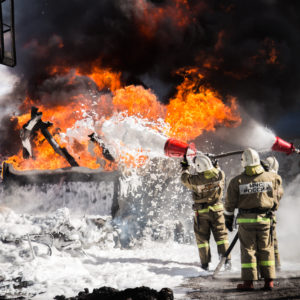Ohio to Collect, Destroy Stockpiles of Toxic Firefighter Foam Amid Lawsuits, Health Concerns
Ohio is among a growing number of states looking to restrict or eliminate PFAS chemicals found in AFFF firefighting foam, which have caused widespread water contamination and expose citizens to toxic, cancer-causing chemicals.

The state of Ohio plans to destroy its stockpiles of aqueous film-forming foam (AFFF), which has been widely used in prior years to combat fuel based fires, but contains high levels of toxic per- and polyfluoroalkyl substances (PFAS), which have caused widespread water contamination in communities nationwide, and been linked to a risk of cancer and other serious side effects.
Ohio Governor Mike DeWine issued a press release on January 29, announcing an initiative to collect and destroy the state’s supply of PFAS-based firefighting foam, called the AFFF Takeback Program. The initiative is being done in cooperation with the Ohio Environmental Protection Agency, the State Fire Marshal’s Office, and a company called Battelle, which has developed what the press release refers to as PFAS Annihilator technology.
PFAS include a group of over 9,000 man-made substances that have been used for decades, to resist grease, oil and water. However, they are known to persist in the environment and build up in the human body, and there is growing evidence linking exposure to a myriad of adverse health effects, including liver damage, thyroid disease, decreased fertility, high cholesterol, obesity, hormone suppression, and cancer.
Use of AFFF products containing PFAS chemicals during firefighting training and response exercises has resulted in widespread water contamination throughout the United States, particularly around military bases, airports and firefighter training locations, and the chemicals have been identified as a serious health threat.
3M Company, DuPont, Chemguard, Inc., Tyco Fire Products and other manufacturers of chemicals and fire safety products now face thousands of PFAS water contamination lawsuits brought by local water providers and individuals diagnosed with various types of cancer. The companies also face hundreds of firefighter cancer lawsuits over exposure to AFFF, and the litigation has further increased concerns about the long-term risks associated with use of the products.

Learn More About
Exposure to firefighting foam chemicals may result in an increased risk of cancer for firefighters, military and airport personnel.
Learn More About this Lawsuit SEE IF YOU QUALIFY FOR COMPENSATIONOhio is one of a growing number of states looking to eliminate AFFF use and reduce the amount of PFAS exposure to the state’s citizens, as well as prevent further water and soil contamination.
In 2021, Maine put in place a ban on the use of all PFAS chemicals in products used in that state, designed to go into effect by 2030. Other states have passed laws restricting its use in certain products, such as firefighting foam and food packaging.
A report released last month by the Environmental Working Group indicated that at least 44 million Americans have drinking water contaminated with PFAS. The environmental group warned that at least 854 water systems nationwide are combatting PFAS contamination.
Ohio Firefighter Foam Removal Initiative
According to the press release, the PFAS Annihilator technology exposes AFFF to supercritical water oxidization, which the governor says can destroy the firefighting foam and reduce PFAS-contamination in wastewater to non-detectable levels.
“Until now, fire departments have had no way to safely dispose of this toxic foam,” DeWine states in the press release. “With this new program, we’ll now be able to completely destroy AFFF to prevent dangerous exposure to PFAS and avoid environmental contamination.”
The initiative is being funded with $3 million the state received as part of a polychlorinated biphenyl (PCB) enforcement case against Monsanto, which resulted from a lawsuit filed by the state in 2018.
Individual Injury PFAS Lawsuits
Given common questions of fact and law presented in thousands of lawsuits against AFFF manufacturers over the cancer risks, coordinated pretrial proceedings have been established in the federal court system before U.S. District Judge Richard M. Gergel in the District of South Carolina, where the claims are currently centralized for discovery and a series of early bellwether trials.
Although the manufacturers have reached proposed settlement over damages sustained by local water suppliers, who have been left with the costs associated with cleaning up the toxic chemicals, there have been no settlements in PFAS injury lawsuits brought by individuals exposed to the chemicals through drinking water, or firefighters directly exposed through AFFF foam.
Last year, Judge Gergel directed the lawyers involved in the litigation to select a group of 28 representative personal injury claims for an AFFF injury bellwether pool, involving plaintiffs who say they were exposed to chemicals that contaminated drinking water.
However, the first cases are unlikely to go before a jury for several years. In addition, the outcome of these claims will not have any binding impact on the other individual lawsuits, although they will be closely watched and may influence how much manufacturers may pay to settle lawsuits brought by other plaintiffs.
Get more articles like this sent directly to your inbox.
"*" indicates required fields






0 Comments